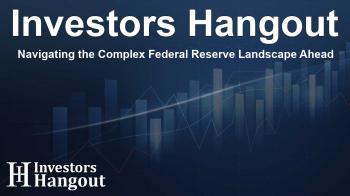Navigating the Complex Federal Reserve Landscape Ahead

Understanding the Challenges Ahead for the Federal Reserve
The Federal Reserve, a key player in the U.S. economy, is on the verge of navigating a landscape filled with uncertainties. With significant progress made over the past two years regarding inflation and economic growth, the upcoming meetings of the Fed need to address new challenges. They will need to consider evolving policies, especially from the new administration, as well as the impact of a turbulent bond market.
Bond Market Dynamics and Borrowing Costs
The bond market is feeling the pressure as borrowing costs move upward. Although the Federal Reserve has been focused on cutting interest rates, the reality is that these efforts come amid rising yields on U.S. government debt. Such changes can significantly influence consumer behaviors, particularly in areas like home mortgages, which are once again seeing higher average rates.
Implications of Rising Rates
Mark Zandi, the chief economist at Moody's Analytics, pointed out just how fragile the bond market appears right now, with rates on 30-year fixed-rate mortgages climbing to around 7%. This jump has raised concerns as it could lead to a shift in consumers' willingness to borrow and invest, which ultimately affects economic growth. Raised borrowing costs could slow down the momentum businesses have gained, undermining recent job growth and consumer spending.
Economic Growth Amid Uncertainty
The unemployment rate has shown remarkable resilience, dipping to as low as 3.4% and ending the previous year at approximately 4.1%. This stability raises questions about the measures traditionally believed to be necessary to keep inflation in check. To date, the inflation rate has been hovering near the Federal Reserve's target of 2%, largely thanks to robust job growth. However, fresh challenges loom regarding potential policy changes that could disrupt this balance.
Policy Changes and Their Potential Effects
The uncertainty surrounding the new administration's policies could bring significant shifts to international trade, immigration, and fiscal matters. In his inaugural address, President Donald Trump hinted at new tariffs that could bring about a wave of inflationary pressures, raising questions about the impact on labor supply—especially in industries reliant on foreign workers, such as housing.
The Fed's Strategy: A Cautious Approach
The Federal Reserve is expected to maintain a cautious stance during its upcoming policy meeting, holding the benchmark interest rate steady at 4.25%-4.50%. However, the true challenge lies in the post-meeting sessions with Fed Chair Jerome Powell, who will need to communicate effectively how these complexities will influence future monetary policy. The impact of the administration’s policies might necessitate adjustments that the Fed currently seeks to avoid.
The Long-Term Outlook for Interest Rates
Expectations of a stable policy rate contrast sharply with how markets perceive future inflation. If long-term yields continue to rise, they could signal market skepticism toward governmental economic strategies. This could compel the Federal Reserve to reassess its approach to inflation management. Importantly, the concerns surrounding government borrowing have not escalated to a point of crisis yet, prompting some Fed officials to express confidence in the current economic trajectory.
Conclusion: Maintaining Economic Growth
In the wider context, despite the potential risks posed by rising long-term yields, officials believe that the current levels are comparable to the economical climate of the mid-2000s, which did not hamper business operations. The need for vigilance remains paramount; hence the Fed will be closely monitoring the situation to navigate a path that supports sustained economic growth without promoting inflation above the desired threshold.
Frequently Asked Questions
What challenges does the Federal Reserve currently face?
The Fed is grappling with rising bond yields and economic uncertainties stemming from new policies from the administration, alongside ongoing inflation control.
Why are rising bond yields a concern?
Rising bond yields increase borrowing costs for consumers and businesses, which can negatively impact economic growth and spending.
How has the unemployment rate changed recently?
The unemployment rate has shown resilience, falling as low as 3.4% recently, but ended the previous year at approximately 4.1%.
What is the Federal Reserve's current interest rate policy?
Currently, the Fed is expected to maintain its benchmark interest rate within the 4.25%-4.50% range during the upcoming policy meetings.
What impact could the new administration's policies have on inflation?
Potential policy changes could create inflationary pressures through tariffs and shifts in labor supply, suggesting a cautious path for the Federal Reserve to navigate.
About The Author
Contact Lucas Young privately here. Or send an email with ATTN: Lucas Young as the subject to contact@investorshangout.com.
About Investors Hangout
Investors Hangout is a leading online stock forum for financial discussion and learning, offering a wide range of free tools and resources. It draws in traders of all levels, who exchange market knowledge, investigate trading tactics, and keep an eye on industry developments in real time. Featuring financial articles, stock message boards, quotes, charts, company profiles, and live news updates. Through cooperative learning and a wealth of informational resources, it helps users from novices creating their first portfolios to experts honing their techniques. Join Investors Hangout today: https://investorshangout.com/
The content of this article is based on factual, publicly available information and does not represent legal, financial, or investment advice. Investors Hangout does not offer financial advice, and the author is not a licensed financial advisor. Consult a qualified advisor before making any financial or investment decisions based on this article. This article should not be considered advice to purchase, sell, or hold any securities or other investments. If any of the material provided here is inaccurate, please contact us for corrections.

